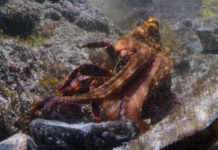- A recent sighting of an ocelot mother and kitten crossing a South Texas road was both heartwarming and worrying, since they’re rare and need more ways to cross roadways safely.
- Most documented ocelot deaths have occurred on Texas roadways — between 2015-2016, eight were killed by vehicles in under a year — with only 60 to 80 ocelots left in the state, such losses are unsustainable.
- Texas has constructed 27 wildlife crossings, many in ocelot-occupied areas, but more are needed, and drivers in those places should also slow down, a new op-ed argues.
- This post is a commentary. The views expressed are those of the author, not necessarily of Mongabay.
On the main road of the Laguna Atascosa National Wildlife Refuge in South Texas, two ocelots recently jumped out in front of a car. The mother ocelot then went back across the road for a kitten in the brush.
Sightings of ocelots like this are rare in the refuge, even though it’s home to a breeding population of these wild cats. Ocelots are typically nocturnal and most active just after sunset and before sunrise, when they can hunt under the cover of darkness. The cats are quite shy and prefer to stay hidden in the brush of their preferred Tamaulipan thornforest habitat. While visitors often spot bobcats at the refuge, this glimpse of the ocelot family was an unusual and special encounter.
Though exciting, its setting on a road is a sobering reminder that when traveling through South Texas, you’re in ‘ocelot country.’
The ocelot is now endangered in the U.S., but it once thrived from South Texas to South America, hiding in the deep grasslands and thornforest. Now, just 1% of the ocelots’ optimal habitat remains in South Texas, most of which is fragmented and separated by high-speed highways.
As a result, accidental vehicle collisions have been an unrelenting threat to ocelots. In the past 20 years, most documented ocelot deaths occurred on Texas roadways. Between 2015-2016, eight ocelots were killed by vehicles over a span of just 11 months. With only 60 to 80 ocelots left in Texas, these losses are both substantial and unsustainable.
The surge of road-killed ocelots over that difficult year, however, prompted fast action and change. Led by Texas Department of Transportation and the U.S. Fish and Wildlife Service, the state has constructed more than 27 wildlife crossings, many built in ocelot-occupied areas. When developing these crossings, the state considered ocelot behavior – they are shy, so the crossings either provide a high level of shelter or were built underground.
Wildlife crossings work and have reduced the number of ocelots killed on roads substantially in South Texas. My organization, Defenders of Wildlife, works with leaders at the federal, state, and local levels to advocate for more wildlife crossings, including a provision of $350 million in the Infrastructure Investment and Jobs Act of 2021, to help improve the options for animals crossing busy roads. Wildlife crossings also help other resident species such as bobcats, armadillos, javelinas, and alligators, and also keep the roads clear for driver safety.
The sighting of the ocelot mother and her kitten crossing the road was both a heartwarming and worrying sight, as it reminds us of the major risks that roads pose to them and other wildlife, and the need to provide animals a way to cross safely.
Sharon Wilcox is senior representative for the Texas program of Defenders of Wildlife, focusing on wildlife habitat connectivity and restoration.
Banner image: Jake Strouf and his wife were driving in the Laguna Atascosa National Wildlife Refuge when they got this rare sighting of ocelots crossing the road. Image courtesy of Jake Strouf.
See related:
Swinging to safety: How canopy bridges may save Costa Rica’s howlers
This story first appeared on Mongabay
South Africa Today – Environment
This article is licensed under a Creative Commons Attribution-NoDerivatives 4.0 International License.
You may republish this article, so long as you credit the authors and Mongabay, and do not change the text. Please include a link back to the original article.












